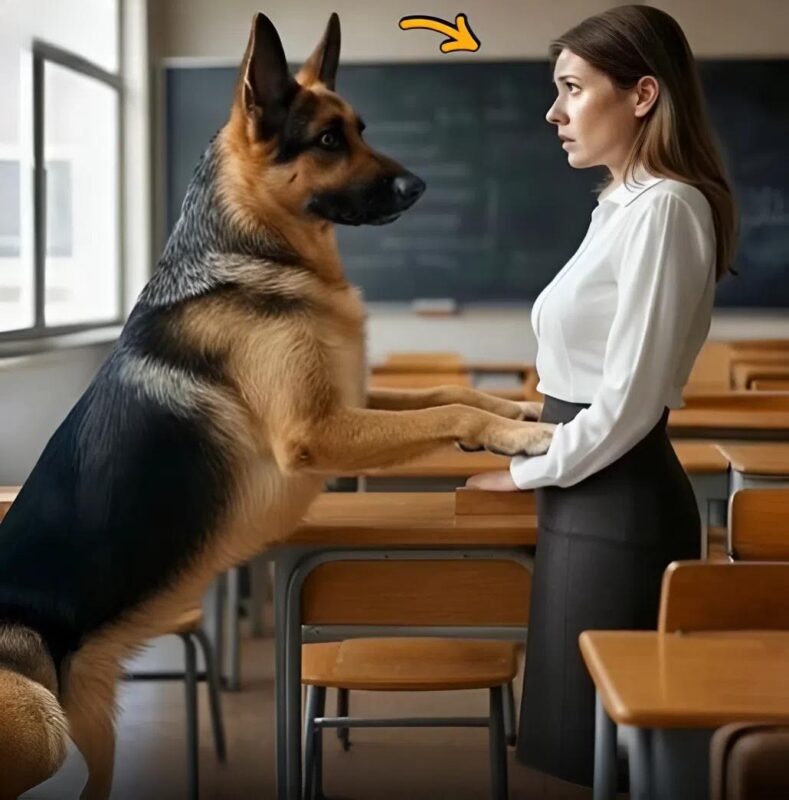The cheerful hum of morning in the elementary school halls—bright murals, giggling kids, the squeak of sneakers—was suddenly pierced by something out of place.
A dog’s bark.
Not just any dog.
Ranger, a retired police K-9, trained to detect danger most humans couldn’t begin to sense.
He was visiting the school with Officer Cane for a student safety event—a fun morning, meant to educate, not alarm.
But Ranger’s ears shot forward. His body went rigid. And then, he barked.
Once. Sharp. Focused. Not random. Not playful.

His eyes locked on one person:
Miss Clara Langston, the beloved second-grade teacher in the red cardigan—the one every child adored.
The classroom fell into a hush. Children stared as Ranger’s bark grew louder. Relentless. Eyes unblinking. Paws anchored to the ground.
Clara’s smile faltered.
She stepped back slightly… toward her desk.
And Ranger snapped into full alert. Low growl. Barking sharper now—urgent, warning, refusing to be ignored.
“Easy, Ranger,” Cane said, tugging the leash gently. But Ranger didn’t budge.
He wasn’t reacting to noise. He was reacting to her.
The children shifted uncomfortably. A few looked scared. Even the classroom fish seemed still.
That’s when Principal Martins stepped in.
“Officer Cane,” he said, tension under his calm voice, “Please remove the dog. He’s scaring the children.”
But Cane didn’t move.
Instead, he walked slowly toward Miss Langston. His voice was quiet. Firm.
“Ma’am… may I look inside your bag?”
Clara’s face drained of color.
She hesitated. Her hands trembled.
“I… I don’t understand,” she whispered.
But Ranger barked again—once.
This time, his gaze shot toward a folder on her desk.
Cane caught the signal immediately. He stepped over and opened the folder.
And then he froze.
Inside were drawings. Crayon-colored outlines of children’s bodies, with red ink circles and annotations in neat, adult handwriting.
Not medical. Not art.
Something else.
Something wrong.
“This isn’t classroom material,” Cane said quietly. “Where did these come from?”
Miss Langston’s voice cracked.
“I was… trying to help,” she whispered. “It’s a technique. I read about it—how children can map emotional pain through drawing. I thought… if I could spot trauma early, maybe I could stop something bad before it happened…”
But she was no licensed therapist.
And the drawings had never been disclosed to the parents.
No consent. No oversight. Just quiet documentation—page after page.
The room went cold.
Miss Langston wasn’t a monster.

But she had crossed a line she never should’ve approached.
She was suspended pending investigation.
Parents were furious.
Some called her dangerous. Others said she was just… lonely. Desperate to feel useful again.
“She’s not evil,” murmured one retired teacher at the school board meeting. “She just lost sight of where care ends and control begins.”
Miss Langston left the school quietly.
Later that year, she moved out of state. Her name never appeared in the headlines—just in whispers, warning other districts to watch more closely.
And Ranger?
He stayed.
He returned to schools with Officer Cane. Kids were taught: never ignore the bark.
Because sometimes, even when humans miss the signs—the dog knows.
And Ranger?
He never barked without a reason.
